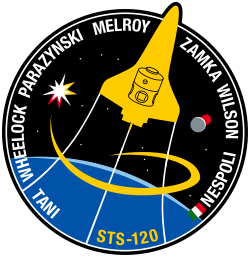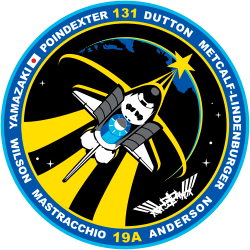Stephanie D. Wilson
| Stephanie Diana Wilson | |
 Stephanie Wilson | |
| NASA-astronaut | |
|---|---|
| Tillstånd | Aktiv |
| Född | 27 september 1966 Boston, Massachusetts |
| Tid i rymden | 42 dagar, 23 timmar, 46 minuter |
| Urvalsgrupp | Astronautgrupp 16 |
| Uppdrag | STS-121, STS-120, STS-131 |
| Uppdragsemblem | |
Stephanie Diana Wilson, född 27 september 1966 i Boston, är en amerikansk astronaut uttagen i astronautgrupp 16 den 5 december 1996.
10 december 2020 valde Nasa ut henne till en av 18 personer till deras Artemisprogram. Det är tänkt att Nasa ska placera en människa på månen år 2024. Och kanske blir Stephanie första kvinnan på månen.[1] I ett första skede handlar det dock om att vara NASAs representanter, i NASAs samarbete med de olika företagen som utvecklar utrustning för Artemisprogrammet.
Rymdfärder
Rymdfärdsstatistik
| Färd | Datum | Tid | EVA |
|---|---|---|---|
| STS-121 | 4 - 17 juli 2006 | 306:37:54 | 00:00:00 |
| STS-120 | 23 oktober - 7 november 2007 | 362:24:00 | 00:00:00 |
| STS-131 | 5 - 2 april 2010 | 362:47:11 | 00:00:00 |
| Totalt | 1031:46:54 | 00:00:00 | |
Externa länkar
 Wikimedia Commons har media som rör Stephanie D. Wilson.
Wikimedia Commons har media som rör Stephanie D. Wilson.
Källor
- ”Biographical Data” (på engelska) (PDF). NASA. januari 2022. https://www.nasa.gov/wp-content/uploads/2016/03/wilson.pdf?emrc=2c80be. Läst 4 maj 2024.
- ^ Sean Potter (9 december 2020). ”NASA Names Artemis Team of Astronauts Eligible for Early Moon Missions” (på engelska). NASA. https://www.nasa.gov/press-release/nasa-names-artemis-team-of-astronauts-eligible-for-early-moon-missions. Läst 10 december 2020.
Media som används på denna webbplats
The STS-120 patch reflects the role of the mission in the future of the space program. The shuttle payload bay carries Node 2, the doorway to the future international laboratory elements on the International Space Station. On the left the star represents the International Space Station; the red colored points represent the current location of the P6 solar array, furled and awaiting relocation when the crew arrives. During the mission, the crew will move P6 to its final home at the end of the port truss. The gold points represent the P6 solar array in its new location, unfurled and producing power for science and life support. On the right, the moon and Mars can be seen representing the future of NASA. The constellation Orion rises in the background, symbolizing NASA's new exploration vehicle. Through all, the shuttle rises up and away, leading the way to the future.
The STS-131/19A crew patch highlights the Space Shuttle in the Rendezvous Pitch Maneuver (RPM). This maneuver is heavily photographed by the International Space Station (ISS) astronauts, and the photos are analyzed back on earth to clear the Space Shuttle's thermal protection system for re-entry. The RPM illustrates the teamwork and safety process behind each Space Shuttle launch. In the Space Shuttle's cargo bay is the Multi-Purpose Logistics Module (MPLM), Leonardo, which is carrying several science racks, the last of the four crew quarters, and supplies for the ISS. Out of view and directly behind the MPLM, is the Ammonia Tank Assembly (ATA) that will be used to replace the current ATA. This will take place during three Extra Vehicular Activities (EVAs). The 51.6° Space Shuttle orbit is illustrated by the three gold bars of the astronaut symbol, and its elliptical wreath contains the orbit of the ISS. The star atop the astronaut symbol is the dawning sun, which is spreading its early light across the Earth. The background star field contains seven stars, one for each crewmember; they are proud to represent the United States and Japan during this mission.
The STS-121 patch depicts the Space Shuttle docked with the International Space Station (ISS) in the foreground, overlaying the astronaut symbol with three gold columns and a gold star. The ISS is shown in the configuration that it will be in during the STS-121 mission. The background shows the nighttime Earth with a dawn breaking over the horizon. STS-121, ISS mission ULF1.1, is the final Shuttle Return to Flight test mission. This utilization and logistics flight will bring a multipurpose logistics module (MPLM) to the ISS with several thousand pounds of new supplies and experiments. In addition, some new orbital replacement units (ORUs) will be delivered and stowed externally on ISS on a special pallet. These ORUs are spares for critical machinery located on the outside of the ISS. During this mission the crew will also carry out testing of Shuttle inspection and repair hardware, as well as evaluate operational techniques and concepts for conducting on-orbit inspection and repair.




